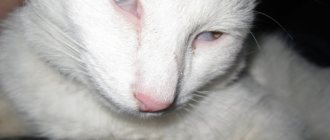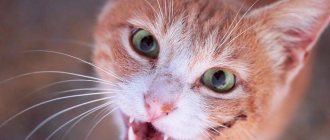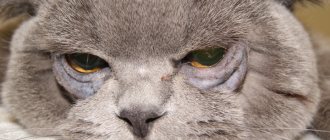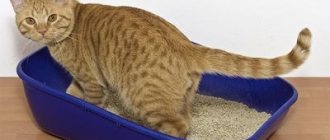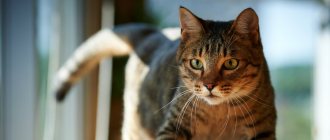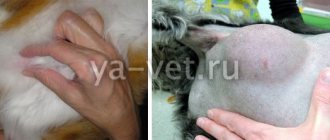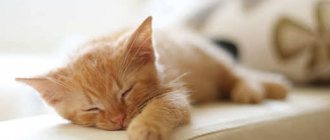Save the article:
In the structure of the cat's eye analyzer there is a translucent membrane called the third eyelid. In a healthy pet, this formation is noticeable only when blinking and half asleep. But in some cases, the fold at the inner corner of the eye swells and extends beyond the lower and upper eyelids. This situation in most cases is a consequence of serious causes and requires timely treatment.
A cat's third eyelid performs several important functions. It protects the cornea of the eye from irritating particles from the outside, distributes the secretion of the lacrimal gland over the surface of the eyeball, and protects the mucous membrane from drying out. If the membrane falls out and becomes noticeable when the cat's gaze is open, then this is a signal for alarm. The reasons for this phenomenon may be different.
Why does pathology develop?
The third eyelid is a fold of the conjunctiva located in the inner corner of the eye, which, in turn, consists of the nictitating membrane - a thin mucous membrane lining the surface of the eyeball and the inside of the eyelid. This membrane moisturizes the cornea with tear fluid and cleans it of debris.
We can say that it resembles a cleaning brush on car windows, performing a similar function. In addition, thanks to the lacrimal gland located at the base of the third eyelid, the cornea is reliably protected from pathogenic microorganisms.
If a cat has a slight covering of the eye with the third eyelid, there is no redness, inflammation, or swelling, then this does not always mean a problem with the eye. Perhaps the organ of vision is sunken due to a reduction in fat caused by weight loss, or the cat flu is developing in your pet.
The causes of third eyelid prolapse are varied. The most common of them include:
- Viral, fungal, bacterial infections.
- Pathologies of internal organs - kidneys, liver, gastrointestinal tract.
- Antibiotic therapy.
- Malfunction of the central nervous or hormonal systems.
- Inflammatory processes in the ears.
- Weak ligaments responsible for the activity of the eyelids.
- Consequence of head injuries.
- Worm infestation.
- A foreign body that has entered the eye and cannot be washed away by the tear fluid on its own.
- Any form of conjunctivitis.
- Adenoma (benign tumor of the third eyelid).
- Atrophy of the eyeball.
Prolapse of the third eyelid can be diagnosed in absolutely any pet, but representatives of the Persian cat breed are most susceptible to this pathology.
How to help your beloved cat: prevention
The disease will not develop if you begin to take systematic preventive measures in time. You can help your pet by trying to protect it from the risk of eye damage or infection in this organ by treating it with special solutions.
For these purposes, experts recommend using chamomile decoction - two filter bags infused in two hundred milliliters of water. Use a cotton pad or swab to rinse the animal’s eyes, and then thoroughly wipe the area around the eyes with an additional cotton pad.
Preventive measures also include reviewing the cat’s diet. The menu should contain only high-quality products. Sweets and processed foods are considered off limits for these furry creatures.
It is recommended to visit a specialist to identify pathologies at an early stage and successfully treat them.
Symptoms
A condition is considered pathological when the third eyelid does not fold and almost completely covers the organ of vision. Experiencing discomfort, the four-legged furry dog begins to rub its face, blink frequently, squint and hide from the irritating light in a secluded place. His eyes turn red, tears flow from them, mucus and pus are released.
Subsequently, a voluminous dense formation is formed in the corners. The temperature often rises.
If one eye is covered with film, then most likely a foreign body has entered it. When there is drooping of the eyelid and narrowing of the pupil, they speak of a pathology of a neurological nature. But if changes are noticed in both eyes, then this is a serious systemic disease.
Often a visible third eyelid is the result of a fight or self-scratching and infection entering the wound. Infection leads to the formation of a creeping corneal ulcer or keratitis. The eye becomes cloudy, erosion appears on the surface with white or greenish discharge. This is a very dangerous condition that can be fatal.
Why is the appearance of the third century dangerous?
In addition to the fact that the pet experiences discomfort, scratches its eyes, blinks intensely, it can suffer from diseases of the internal organs and parasites. There is only one symptom, but the causes are different, and all of them are unfavorable for the cat’s body.
Untreated eye infections are dangerous: they can lead to blindness or affect the brain. Benign tumors (adenomas) are dangerous, as they lead to the same consequences.
Infection with worms is unpleasant, because the animal has itching in the eyes and under the tail, and has a poor appetite. Regular anti-parasitic procedures are recommended for all pets - even those that do not go outside.
Bacteria, fungi, viruses, allergies, as mentioned above, also lead to inflammation of the third eyelid in cats. Many infectious diseases can lead to irreversible complications and death, and allergies can develop into bronchial asthma.
Even when all the bad things are over, the third eyelid can fall out due to stress and weakened immunity of the animal, as well as after undergoing operations. Here you need to choose the right vitamins, under the guidance of a veterinarian, and create a calm, cozy atmosphere at home.
Diagnostic methods
Diagnosis is aimed at determining the etiology. To make a diagnosis, a comprehensive examination of the animal is carried out, including the following measures:
- taking anamnesis;
- visual inspection;
- general and biochemical blood tests;
- flushing from the mucous membranes of the eyes;
- ultrasonography;
- PCR diagnostics.
After identifying the cause of the pathological condition (third eyelid in a cat), the veterinarian prescribes appropriate treatment.
Third eyelid in a cat: when treatment is not required
When a mucous membrane covers part of a cat's eye, it is not always a sign of a serious pathological condition .
Be sure to read:
A cat's teeth are falling out: physiological and pathological reasons, what to do, prevention
In some cases, you can do without the use of drugs:
- severe weight loss or dehydration;
- recovery after a serious illness;
- decreased immunity;
- mild form of cat flu.
In case of these disorders, you need to carefully monitor the pet’s condition and make sure that he receives a sufficient amount of vitamins and other useful substances from his food. If necessary, you need to regularly remove discharge from the nose and eyes.
Treatment, prognosis
To eliminate infectious pathologies, therapy is practiced, which is based on antiviral and antifungal drugs. Their task is to suppress the development of pathogenic microorganisms.
The animal is also prescribed antipyretics, painkillers, and immunostimulants and vitamin-mineral complexes to strengthen the immune system.
If prolapse of the third eyelid is associated with an allergic reaction, then the allergen is eliminated and antihistamines are prescribed. For general improvement of the condition, hormonal agents are indicated (in advanced stages).
Eye injuries are treated by using anesthetic drops and rinsing to remove foreign bodies and debris. Surgery is performed only in severe cases.
If the prolapse of the third eyelid is caused by an adenoma, but the neoplasm does not grow and does not bother the animal, then removal of the benign tumor is not carried out. The operation may have unpleasant consequences, such as dry eye syndrome. As a rule, veterinarians limit themselves to supportive therapy.
Treatment of third eyelid prolapse at home
Treatment of diseases accompanied by prolapse of the third eyelid is carried out only after the diagnosis has been established.
Eye wash
Eye rinsing becomes necessary if there is discharge. For this we use:
- saline;
- aqueous solution of furacillin;
- aqueous solution of chlorhexidine;
- boric acid solution;
- eye lotions: Beafar Ophtal;
- Dewdrop.
- calendula;
How to wash your cat's eyes:
- Prepare and place the rinsing solution and napkins nearby, or you can use a syringe without a needle.
- If the cat is excitable, then swaddle it with a towel.
- Soak a napkin in the solution and wipe the cat's eyelids, removing dirt. You can irrigate the eyeball with a solution from a syringe. If the cat's eyelids are stuck together, you should apply a napkin well moistened with the solution to them for two minutes, after which the eye will open. You should not try to force open a cat's eye - this will result in injury to the eyelids. It is important to avoid touching the tissues to the eyeball.
- Dry the cat's eyelids with a dry cloth.
- Repeat the action with the other eye, using another napkin.
Drops should be instilled only after clearing the eye of secretions
Eye drops
Eye drops are instilled after washing the eyes; it is advisable to maintain an interval of 2–5 minutes to avoid interaction between the components of the lotion and the drops. Drops are instilled into a pocket from the conjunctiva, bending the edge of the lower eyelid. After instilling the drug, close the cat's eye and lightly massage the skin of the upper eyelid, promoting even distribution of the drops. The drops can cause a burning sensation and discomfort in your cat's eyes, so you should prevent your cat from scratching the eyes with his paws by holding them or putting a protective collar on the cat.
Table: eye drops used for third eyelid prolapse in cats
| A drug | Compound | Indications | Contraindications | Price, rub |
| Levomycetin | Levomycetin | Inflammatory eye diseases caused by microflora sensitive to the drug: conjunctivitis, keratitis, blepharitis. Infected eye wounds. After ophthalmic surgery to prevent infection. Instill 3-4 times a day for at least 5 days | Hypersensitivity to chloramphenicol. If there is no positive dynamics within 3–5 days, the drug should be replaced | 11 |
| Iris | Gentamicin | Inflammatory eye diseases: conjunctivitis, keratitis, corneal erosions and ulcers, blepharitis, uveitis. Instilled 4 times a day for 7–10 days | Hypersensitivity to the components of the product | 129 |
| Tsiprovet | Ciprofloxacin | Acute and chronic conjunctivitis, keratitis, corneal ulcers, septic iridocyclitis, blepharitis. A very wide spectrum of action, affects chlamydia, mycoplasma, Staphylococcus aureus and Pseudomonas aeruginosa. Apply 4 times a day for 7–14 days | Intolerance to fluoroquinolone antibiotics. Not for use in kittens less than 7 days old. Use with caution in cats with cerebrovascular accidents | 196 |
| Dekta-2 | Gentamicin, dexamethasone | Conjunctivitis, keratitis, iridocyclitis, blepharitis, including those of allergic origin. Before and after ophthalmological operations. For eye injuries. Instill 2 drops 2-3 times a day for 5-10 days | Hypersensitivity to the components of the drug. Concomitant use with other drugs containing corticosteroids. Should not be used for infectious eye lesions of non-bacterial etiology. | 135 |
| Ofthalmosan |
| Treatment and prevention of conjunctivitis, keratitis, blepharitis. In case of eye injuries, exposure to irritating substances, ingress of foreign bodies. To prevent the development of age-related degenerative changes in the cornea and retina. Apply 1-3 times a day, 2-3 drops for a course of 7-14 days. If it is necessary to continue treatment, an interval of 5–10 days is maintained between courses. To prevent eye diseases in older cats, use 1–2 drops 2 times a day for a course of 20 days. If it is necessary to continue treatment, maintain an interval between courses of 10 days | Hypersensitivity to the components of the drug. Simultaneous use with alkaline solutions. Avoid accidental combination with soap solution | 185 |
| Lacrimin | Levomycetin, sodium sulfalicylate | Conjunctivitis (catarrhal, purulent, follicular), keratitis, blepharitis, infected eye wounds, complications after ophthalmological operations. Apply 2-3 times a day, 2-3 drops for a course of at least 5 days | Hypersensitivity to the components of the drug | 249 |
| Leopard | Levomycetin, furacillin | Treatment and prevention of conjunctivitis, keratitis, blepharitis. Prevention of eye infections after surgery and foreign bodies. Apply 1-2 drops 3-4 times a day for 7-14 days. Also used to cleanse the eyes for eye diseases. | 159 | |
| Lachrikan | Polysept, anesthesin, menthol | Prevention and treatment of bacterial conjunctivitis and blepharitis. It has antimicrobial, anti-inflammatory, local anesthetic and enveloping effects. Apply 1-2 drops 2-3 times a day for a course of 8-10 days. If necessary, continue treatment, make a one-week interval between courses | 75 | |
| Anandin | Glucoaminopropylcarbacridone | For the treatment of conjunctivitis, including infectious diseases. Has antimicrobial, anti-inflammatory, healing effects. Apply 2–3 drops 2 times a day for 5–7 days | 75 | |
| Forvet | Panavir, taurine | For the treatment of infectious diseases of the conjunctiva and cornea as part of complex therapy. Has a healing effect. Apply 1 drop 4–5 times a day for 7–30 days | 324 |
Eye drops should be prescribed by a veterinarian, since they differ in the combination of effects they provide, the range of effects on pathogens, as well as the ability to penetrate into the deep structures of the eyeball, which is necessary for corneal ulcers, uveitis, and some keratitis.
A veterinarian should prescribe eye drops after confirming the diagnosis.
Eye ointments
Eye ointment, unlike drops, lingers in the conjunctival sac for a longer time and does not require as frequent use as drops. It is very convenient to use eye ointment at night.
The eye ointment is placed in the cat's eye, bending the edges of the lower eyelid, into the space between its conjunctiva and the front surface of the eye - just like drops. To apply the ointment, you can use a glass spatula or squeeze it out of the tube, but it is best to use your own finger after pre-treating your hands with a chlorhexidine solution - this will protect the eye from accidental injury when the cat moves suddenly. Just like after instilling drops, close the cat’s eyelids and lightly massage, helping the ointment to distribute evenly.
Table: eye ointments used for prolapse of the third eyelid in a cat
| A drug | Compound | Indications | Contraindications | Price, rub |
| Tetracycline ointment 1% | Tetracycline | Inflammatory eye diseases: conjunctivitis, blepharitis, keratitis, including chlamydial keratitis, trachoma. Apply 3 times a day | Hypersensitivity to tetracyclines. Should not be used in pregnant cats during the first half of pregnancy as there is a small potential for tetracycline exposure to developing kittens. It is not indicated in the instructions, but it is also not necessary to use it in kittens, at least until teeth change. | 44 |
| Erythromycin ointment | Erythromycin | Hypersensitivity to macrolides. Can be used in pregnant cats and kittens | 113 | |
| Hydrocortisone ointment | Hydrocortisone | Conjunctivitis, keratitis, uveitis of allergic or autoimmune origin. Has a powerful anti-inflammatory effect. Prescribed exclusively by a veterinarian. Apply 2–3 times a day | Pregnancy, breastfeeding, glaucoma, infectious nature of inflammation. Uncontrolled use will result in corneal ulcers, cataracts, and the development of glaucoma. | 67 |
| Floxal ointment | Ofloxacin | Conjunctivitis, keratitis, uveitis, blepharitis, corneal ulcers, including those caused by chlamydia and mycoplasmas. Apply 3 times a day | Pregnancy, individual hypersensitivity to fluoroquinolones | 156 |
| Colbiocin ointment | Tetracycline, chloramphenicol, colistin | It has a wide spectrum of action, destroying bacteria, fungi, rickettsia, mycoplasma and chlamydia. Used for the treatment of: conjunctivitis, keratitis, ulcerative lesions of the cornea, dacryocystitis, uveitis. Apply 3-4 times a day | Individual hypersensitivity to the components of the product, pregnancy, breastfeeding | 300 |
As a rule, ophthalmic drugs are used for prolapse of the third eyelid, which accompanies eye diseases, as well as eye damage caused by the development of infectious diseases, for example, conjunctivitis with panleukopenia, calicivirosis, viral leukemia. Ocular manifestations in these cases are also symptoms of a systemic infectious process, but the use of ophthalmic medications improves the condition of the eyes and the well-being of the cat.
Photo gallery: ophthalmic drugs for the treatment of third eyelid prolapse
Tetracycline ointment has a broad spectrum of action, but is not used during pregnancy
Erythromycin ointment can be used in pregnant cats
Lacrican has anti-inflammatory, antimicrobial and local anesthetic effects, but does not penetrate the internal structures of the eye, therefore it is used to treat conjunctivitis and blepharitis
Tsiprovet has a wide spectrum of action and the ability to penetrate the internal structures of the eye
Oftalmosan can be used both for the treatment of inflammatory eye diseases and for the prevention of age-related dystrophic changes in the cornea and retina
Use of special drugs
In situations where prolapse of the third eyelid is caused by a general disease, it is necessary to carry out therapy aimed at its cause:
- infectious diseases - used: antibacterial drugs: Sinulox;
- Tsiprovet;
- Baytril.
- saline;
- interferons;
- anthelmintic drugs: Pratel;
- Ringer's solution;
- corticosteroids: Prednisolone;
- Tavegil;
- cytostatics;
Features of therapy for kittens and pregnant cats
In the treatment of kittens and pregnant cats, early examination by a veterinarian is of great importance, since the choice of medications for the treatment of this category of pets is limited. For pregnant cats, the diagnosis affects the prospects for further continuation of pregnancy, as well as the tactics of further treatment - whether it is carried out in the interests of the kittens or in the interests of the cat when there is an immediate threat to its life.
What to do at home
The owner must strictly follow the veterinarian’s instructions and provide the pet with good living conditions, rest and adequate nutrition. It is recommended to reduce physical activity.
Under no circumstances should you self-medicate or use medications purchased without consulting a specialist.
Remember that if you try to insert a membrane yourself, you can cause irreparable harm to your vision.
During treatment, the cat must rinse its eyes. But for this you should not use the good old folk methods, such as strong tea, but special drugs that relieve inflammation.
A good result is obtained by the Beaphar Oftal eye wash, sold in a veterinary pharmacy. It does an excellent job of cleaning the eyes and fur around them from debris, stimulates self-cleaning and prevents the appearance of tear stains.
After washing the organ of vision, eye drops are used. Among those recommended by veterinarians are Actipol, Levomycetin, Floxal. These drugs are most effective for conjunctivitis and infections. The use of two drugs simultaneously enhances the therapeutic effect. As a rule, experts advise combining Floxal with Korneregel. The course is at least 14 days.
Drops are the most optimal form of the drug. Gel or ointment is much more difficult to apply. The drug is placed under the lower eyelid with the index finger (in no case directly from the tube!). To ensure that it is evenly distributed, the eye must be massaged. Immediately before the procedure, nails should be trimmed, otherwise the cat may be injured.
The pet will resist manipulation, so it needs to be secured with a blanket or thick towel.
Prevention
To prevent third eyelid loss, certain preventive measures must be followed. They relate to caring for the animal and maintaining its health. Firstly, the cat must be vaccinated in a timely manner. The vaccination schedule is reflected in the animal's passport indicating the date, name of the vaccine and its dosage. It is advisable to protect your pet from stray relatives who are a source of infections.
Secondly, you should regularly deworm kittens and adults with your pet. Thirdly, the cat needs neat bedding, treated from parasites, a sanitized tray with clean filler. Fourthly, a complete and balanced diet with nutrients and vitamins is of great importance. High-quality food supports the cat’s immunity and helps to avoid serious diseases.
Prolapse of the third eyelid is an unpleasant phenomenon for a cat and its owner. In addition to creating discomfort and burning, this problem may indicate the presence of dangerous diseases that threaten not only the well-being, but also the life of the pet. That is why, when an eye defect is first detected, it is necessary to contact a veterinarian and determine the cause. Timely treatment helps to return your pet to health and peace without consequences.
Manifestations of the disease
If the owner knows the symptoms of the disease, then he will be able to identify bloat in the cat and provide timely assistance to the pet. First of all, when the eyelid rolls up, irritation of the cornea of the eye begins. Entropion of the eyelids is accompanied by other noticeable symptoms. Manifestations of the disease are presented in increasing order as it progresses :
- redness of the eyes;
- profuse lacrimation;
- swelling of the cornea of the eye;
- external reduction in eye size;
- change in the shape of the palpebral fissure due to the fact that the eyelid has rolled up;
- constant moisture in the fur around the eye;
- formation of a purulent mass in the corner of the eye;
- corneal ulcer;
- perforation of the eye.
At the last stage of the disease, a rolled eyelid causes such serious and irreversible changes in the cat's eye that it is impossible to save it. If you return the eyelid to the correct position in time, the problem will be completely eliminated.
© shutterstock
What to do if your dog has a prolapsed tear gland?
If you find a similar pattern in your pet, apply tetracycline eye ointment to the lacrimal gland. It will create a layer between the gland and the environment and slow down the swelling. Next, your pet will have to visit an ophthalmologist, where the doctor will either mechanically or surgically realign the lacrimal gland. Do not delay your visit to the ophthalmologist, because the sooner you bring your pet, the shorter the rehabilitation period and course of treatment. Remember that these glands are very necessary for your pet, they cannot be removed!
Photo before surgery Photo immediately after surgery
Ophthalmologist of your pet Yastrebov Oleg Vladimirovich.
Join us on social networks
Causes
The rudimentary membrane of the third eyelid, when folded, is adjacent to the inner corner of the eye. Its movement at the moment of blinking cleans and lubricates the surface of the organ of vision. When a cat's eyes are half covered with film or it falls out, the animal experiences discomfort. Redness of the mucous membrane indicates the onset of third eyelid prolapse. The pupil constricts and this causes severe visual irritation. The cat is trying to hide from the light source.
There can be several reasons for eyelid loss:
- mechanical damage to an organ during a fight;
- allergy;
- nervous system disorders;
- helminthic infestations;
- damage to the base of the eyelid;
- muscle weakness;
- poisoning;
- conjunctivitis;
- inflammation of the ears;
- viral and bacterial infections;
- entry of foreign bodies.
Any cause of prolapse can cause severe consequences, so the appearance of a third eyelid should make the owner of the animal wary. Signs of illness require seeking qualified help.
Suturing the lacrimal gland of the third eyelid
There are several types of surgical reduction of the lacrimal gland of the third eyelid. Each method is selected individually for the patient and is performed under general anesthesia. The operation is low-pain and short-term. The duration of such surgery for both eyes is up to 20-30 minutes for both eyes.
The likelihood of recurrence after surgical reduction is quite low. In the postoperative period, it is important to prevent the patient from self-injury, therefore all animals after surgery are recommended to wear a collar.



